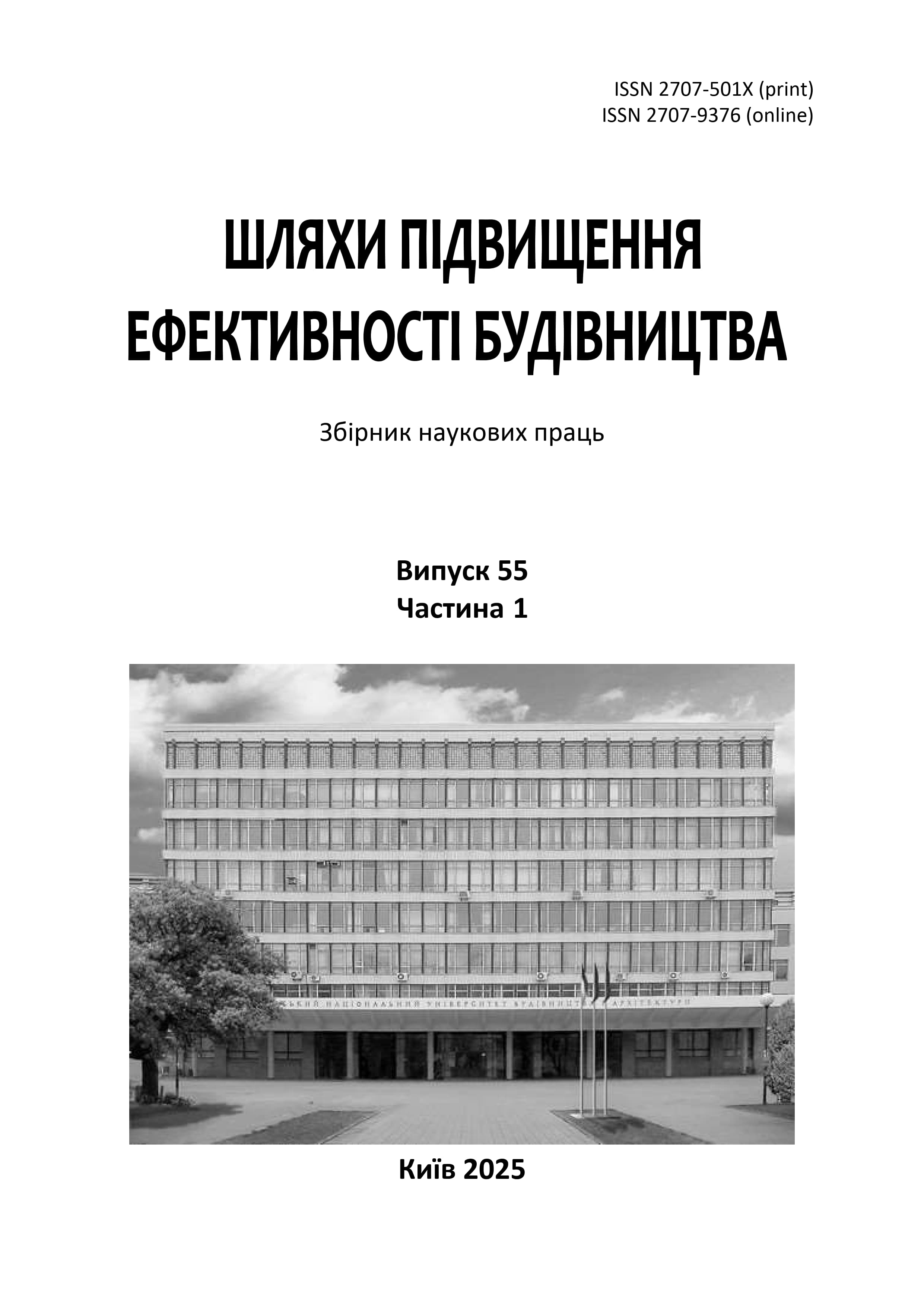Stability of the shell of the minimum surface on a trapezoidal contour, taking into account geometric nonlinearity under thermal and power loading
DOI:
https://doi.org/10.32347/2707-501x.2025.55(1).48-60Keywords:
shell stability, multicriteria parametric optimization, minimum surface shell, shell stability calculation, geometric nonlinearity, nonlinearity, FEM, power loads, static loads, finite element methodAbstract
For the calculation of spatial thin-walled structures, it is necessary to perform verification calculations for two groups of limit states. The first group of limit states includes strength and stability calculations. The second group of limit states includes deflection and crack resistance calculations.
The object of study is a shell of minimal surface on a trapezoidal contour, which is a thin-walled spatial structure. This type of shell is used in the following industries: mechanical engineering, chemical industry, aircraft construction, and drone construction. They have high strength, rigidity and lightness, and are easy to manufacture.
The shells of minimal surfaces, which are studied by traditional methods of mathematical physics, are not sufficiently studied due to the unique thin-walled structures that were derived by optimizing the shape on a given contour. Recently, the creation of advanced structures, high-performance machines and special-purpose objects often leads to the need to develop structural shell elements with a complex geometric structure - which are the shells of minimal surfaces.
The essence of the geometrically nonlinear formulation is to find the actual displacements of the finite element model when studying the loss of global stability of the shell of the minimum surface on a trapezoidal contour, as well as to find the special places where the actual loss of stability occurs on the mid-surface. This methodology allows to calculate the loss of stability of the minimum surface shell with a high enough accuracy, which leads to the optimization of stability in multi-criteria parametric optimization.
Numerical studies were carried out using the finite element method (FEM). After creating the finite element model, a combination of external loads was set in accordance with the building codes of Ukraine. Next, an initial stability calculation was performed, which showed that the first four forms of stability loss have a strain energy coefficient of less than one. The thickness of the shell of the minimum surface on the trapezoidal contour was selected as follows, the minimum strain energy on the first form of loss of stability was a factor of 1.0, while the required thickness was 36 mm.
References
Герасимов, Е.Н., Почтман Ю.М., Скалозуб В.В. Многокритериальная оптимизация конструкций. Киев: Вища школа, 1985. 134 с.
Гилл Ф., Мюррей У., Райт М. Практическая оптимизация. М.: Мир, 1985. 509 с.
Ігнатишин М.І. Механіко-математичне моделювання елементів мостових конструкцій (опора, балка, плита): монографія. Мукачево: РВВ МДУ, 2017. 172 с.
Іванченко Г.М., Кошевий О.О., Кошевий О.П. Чисельна реалізація багатокритеріальної параметричної оптимізації оболонки мінімальної поверхні на квадратному контурі при термосиловому навантаженні. Опір матеріалів і теорія споруд.2022. Вип. 109. С. 50-65 DOI: 10.32347/2410-2547.2022.109.50-65
Іванченко Г.М., Кошевий О.О., Кошевий О.П., Григор’єва Л.О. Чисельне дослідження параметричної оптимізації вимушених частот коливання оболонки мінімальної поверхні на трапецевидному контурі при термосиловому навантаженні. Опір матеріалів і теорія споруд. 2023. Вип. 110. С. 430-446. DOI: 10.32347/2410-2547.2023.110.430-446
Іванченко Г.М., Кошевий О.О., Жупаненко І.В. Оптимальне проектування вимушених частот коливання оболонки мінімальної поверхні на круглому контурі, яка складається із двох похилих еліпсів при термосиловому навантаженні. Шляхи підвищення ефективності будівництва в умовах формування ринкових відносин. 2023. № 51. С. 218-233. DOI: 10.32347/2707-501x.2023.51(1).218-233
Юрченко В.В., Пелешко І.Д. Пошук компромісного розв’язку в задачах оптимізації розмірів поперечних перерізів елементів конструкцій з холодногнутих профілів. Опір матеріалів і теорія споруд. 2022. Вип. 109. С. 72-92. DOI: 10.32347/2410-2547.2022.109.72-92
Іванченко Г.М., Кошевий О.О. Чисельне дослідження стійкості оболонки мінімальної поверхні на круглому плані з урахуванням геометричної нелінійності при термосиловому навантаженні. Шляхи підвищення ефективності будівництва в умовах формування ринкових відносин. 2024. № 53. С. 39-48. DOI: 10.32347/2707-501x.2024.53(1).39-48
Кошевий О.О. Чисельне дослідження стійкості оболонки мінімальної поверхні на квадратному контурі при термосиловому навантаженні з урахуванням геометричної нелінійності. Прикладна геометрія і інженерна графіка. 2024. №106. С. 133-147. DOI: 10.32347/0131-579X.2024.106.133-147
Кошевий О.О., Іванченко Г.М., Затилюк Г.А. Багатокритеріальна параметрична оптимізація переміщення і ваги оболонки мінімальної поверхні на круглому контурі, що складається із двох похилих еліпсів при термосиловому навантаженні з урахуванням геометричної нелінійності. Опір матеріалів і теорія споруд. 2024. Вип. 112. С. 209-221.
Юрченко В.В., Пелешко І.Д. Параметрична оптимізація сталевої решітчастої рами з несучими елементами із круглих труб. Опір матеріалів і теорія споруд. 2021. Вип. 107. С. 45-74. DOI: 10.32347/2410-2547.2021.107.45-74
Perelmuter A.V., Yurchenko V.V., Peleshko I.D. Optimization of cross-sectional dimensions for coldformed steel lipped channel columns. Опір матеріалів і теорія споруд. 2022. Вип. 108. С. 156-170. DOI: 10.32347/2410-2547.2022.108.156-170
Yurchenko V.V., Peleshko I.D. Parametric optimization of steel structures based on gradient projection method. Опір матеріалів і теорія споруд. 2020. Вип. 105. С. 192-220. DOI: 10.32347/2410-2547.2020.105.192-220.
Кривошапко С.В., Иванов В.Н., Халаби С.М. Аналитические поверхности: материалы по геометрии 500 поверхностей и информация к расчету на прочность тонких оболочек. М.: Наука, 2006. 544 с.
Downloads
Published
How to Cite
Issue
Section
License

This work is licensed under a Creative Commons Attribution 4.0 International License.
Authors who publish with this journal agree to the following terms:
- Authors retain copyright and grant the journal right of first publication with the work simultaneously licensed under a Creative Commons Attribution License that allows others to share the work with an acknowledgement of the work's authorship and initial publication in this journal.
- Authors are able to enter into separate, additional contractual arrangements for the non-exclusive distribution of the journal's published version of the work (e.g., post it to an institutional repository or publish it in a book), with an acknowledgement of its initial publication in this journal.
- Authors are permitted and encouraged to post their work online (e.g., in institutional repositories or on their website) prior to and during the submission process, as it can lead to productive exchanges, as well as earlier and greater citation of published work (See The Effect of Open Access).

